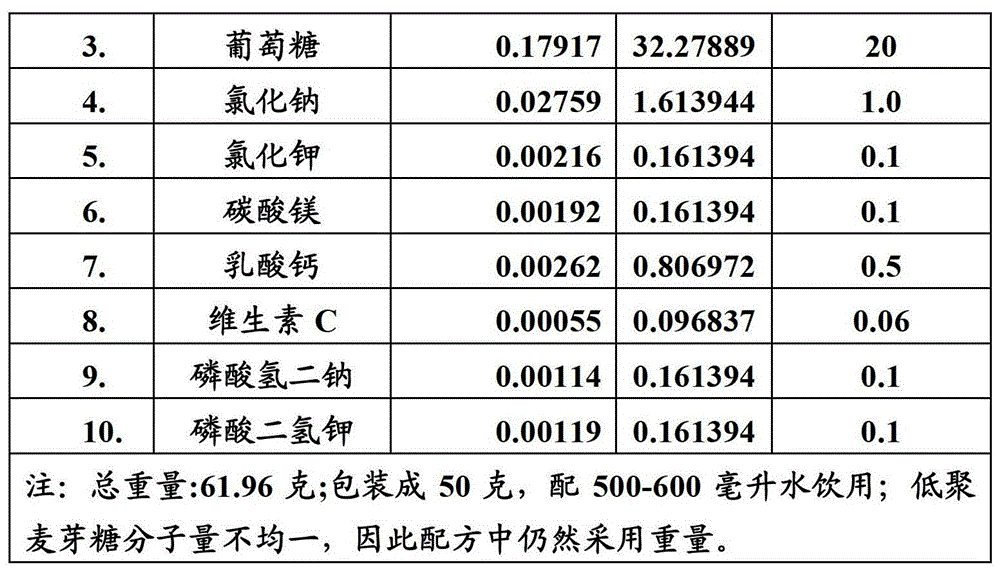Electrolyte beverage
An electrolyte and beverage technology, which is applied in the directions of sugar-containing food ingredients, inorganic compound-containing food ingredients, and functions of food ingredients, etc., can solve the problems of aggravating the loss of body fluid, fluid loss, and consumption, etc., and achieves high physical load and energy supply. Fast and long-lasting results with high fluid loss
- Summary
- Abstract
- Description
- Claims
- Application Information
AI Technical Summary
Problems solved by technology
Method used
Image
Examples
Embodiment 1
[0039] Embodiment 1 Electrolyte solid drink formula
[0040] See Table 1:
[0041] Table 1 Formula of electrolyte solid drink
[0042]
[0043]
[0044] The above raw materials are prepared into required dosage forms through processes such as pulverization, sieving, proportioning weighing, mixing and stirring.
[0045] The solid electrolyte drink of the above formula is rehydrated with drinking water, and then made into an 8%-10% (mass / volume percentage) solution. The taste is slightly sweet and slightly salty, pH=4.5, osmotic pressure is 277mOsM, basically isotonic.
[0046] In the following two examples:
[0047] The solid electrolyte drink of the present invention is made into a 10% (mass / volume percentage) solution, and the test is compared with the Gatorade drink, which is a commercially available bottled drink. Compare the two drinks on the swimming endurance of mice and the "recovery" ability of humans after exercise.
[0048] Gatorade drink ingredients: water...
Embodiment 2
[0050] Example 2 Solid Electrolyte Beverage Promotes Athletic Ability Experiment—Swimming Endurance Experiment in Mice
[0051] Forty Balb / c male mice, weighing 30.2±3.6 grams, aged 6 weeks, were randomly divided into two groups after three days of adaptive feeding, 20 mice in the Gatorade beverage exercise group (group A), and solid electrolyte beverage exercise group (group A). Group B) 20 rats. The mice in the electrolyte drink group were fed with 8%-10% solid electrolyte drink solution (2 g solid drink / Kg body weight) every day for one week, while the mice in group B were given the same amount of Gatorade drink every day. After feeding for 5 minutes every day, the two groups of mice underwent swimming training for 20 minutes. On the 8th day, 5 minutes after all the mice were fed with the above method, 40 mice entered the water for swimming, and swam to exhaustion (the exhaustion standard was set as sinking to the bottom for 3 seconds), and the swimming to exhaustion of ea...
Embodiment 3
[0055] Example 3 Test of Solid Electrolyte Beverage on Improving Exercise Capacity and Promoting Post-exercise Recovery——Post-exercise "Recovery" Experiment
[0056] Validation of the effect of solid electrolyte drinks on exercise performance and recovery. The experiment adopts a cross-over experimental design, and the subjects are randomly divided into two groups, A and B, with 15 people in each group, and the cross-over experiment is carried out. Experimental design see figure 1 .
[0057] Subject's maximum oxygen uptake (VO 2 max) measurement: the test subject load is a Monark power bicycle, and starts pedaling from the initial load of 50W, and increases step by step at 25w / min until the stop index or the test subject requests to stop the test. During the exercise, the cardiopulmonary function instrument was used to analyze the gas metabolism indicators of the subjects. Target heart rate = 220 - age. The stop indicator is: when the target heart rate is stable for 1 min...
PUM
 Login to View More
Login to View More Abstract
Description
Claims
Application Information
 Login to View More
Login to View More - R&D
- Intellectual Property
- Life Sciences
- Materials
- Tech Scout
- Unparalleled Data Quality
- Higher Quality Content
- 60% Fewer Hallucinations
Browse by: Latest US Patents, China's latest patents, Technical Efficacy Thesaurus, Application Domain, Technology Topic, Popular Technical Reports.
© 2025 PatSnap. All rights reserved.Legal|Privacy policy|Modern Slavery Act Transparency Statement|Sitemap|About US| Contact US: help@patsnap.com



